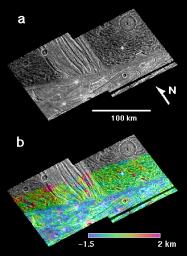
|
Erech Sulcus, Ganymede
- Click the image above for a larger view
- Full-Res JPEG (328 x 450) (35.1 kB)
- Full-Res TIFF (328 x 450) (141.7 kB)
Caption:
Terrain units and topography of the area where a bright swath called Erech Sulcus intersects northern Sippar Sulcus on Jupiter's moon Ganymede are shown in these two frames derived from images of Jupiter's moon Ganymede by NASA's Galileo and Voyager spacecraft.
The left frame (a) is a mosaic of images taken by Galileo with a resolution of 140 meters (460 feet) per pixel. Erech Sulcus is the band of grooved terrain extending north-south between two blocks of older, dark terrain. It is about 75 meters (about 250 feet) wide. A portion of Sippar Sulcus, nearly perpendicular to Erech Sulcus, lies to the south. A caldera to the right is truncated by a narrow lane of Sippar's smooth terrain.
The right frame (b) shows a digital elevation model of the three-dimensional shape of the same scene. Relative elevation values, estimated from comparison of Galileo and lower-resolution Voyager images, have been color-coded and merged with the image mosaic. The bright terrain of Sippar Sulcus lies at a lower elevation than the dark terrain bordering it.
These images were prepared by the Lunar and Planetary Institute, Houston, and included in a report by Dr. Paul Schenk et al . in the March 1, 2001, edition of the journal Nature .
Background Info:
The Jet Propulsion Laboratory, a division of the California Institute of Technology in Pasadena, manages the Galileo and Voyager missions for NASA's Office of Space Science, Washington, D.C.
Images and data received from Galileo are posted on the Galileo mission home page at http://www2.jpl.nasa.gov/galileo/ . Background information and educational context for the images can be found at http://www2.jpl.nasa.gov/galileo/sepo/ .
Cataloging Keywords:
| Name | Value | Additional Values |
|---|---|---|
| Target | Ganymede | |
| System | Jupiter | |
| Target Type | Satellite | |
| Mission | Galileo | Voyager |
| Instrument Host | Galileo Orbiter | |
| Host Type | Orbiter | Flyby Spacecraft |
| Instrument | Solid-State Imaging (SSI) | |
| Detector | ||
| Extra Keywords | Color | |
| Acquisition Date | ||
| Release Date | 2001-03-13 | |
| Date in Caption | 2001-03-01 | |
| Image Credit | NASA/JPL/LPI | |
| Source | photojournal.jpl.nasa.gov/catalog/PIA03215 | |
| Identifier | PIA03215 | |
